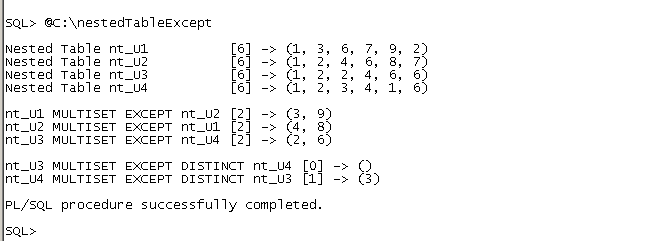|
DECLARE
|
|
nt_u1 nt_numtype := nt_numtype(1,3,6,7,9,2);
|
|
nt_u2 nt_numtype := nt_numtype(1,2,4,6,8,7);
|
|
nt_u3 nt_numtype := nt_numtype(1,2,2,4,6,6);
|
|
nt_u4 nt_numtype := nt_numtype(1,2,3,4,1,6);
|
|
nt_ex1 nt_numtype := nt_numtype();
|
|
FUNCTION op_nt(i_nt IN nt_numtype) RETURN VARCHAR2 IS
|
|
s_Nested_tab VARCHAR2(200);
|
|
BEGIN
|
|
IF i_nt.COUNT > 0 THEN
|
|
FOR idx IN i_nt.FIRST .. i_nt.LAST LOOP
|
|
IF idx < i_nt.COUNT THEN
|
|
s_nested_tab := s_nested_tab||i_nt(idx)||', ';
|
|
ELSE
|
|
s_nested_tab := s_nested_tab||i_nt(idx);
|
|
END IF;
|
|
END LOOP;
|
|
ELSE
|
|
s_nested_tab := '';
|
|
END IF;
|
|
RETURN s_nested_tab;
|
|
END op_nt;
|
|
BEGIN
|
|
DBMS_OUTPUT.PUT_LINE(CHR(10)||'Nested Table nt_U1 ['||nt_u1.COUNT||'] -> ('||op_nt(nt_u1)||')');
|
|
DBMS_OUTPUT.PUT_LINE('Nested Table nt_U2 ['||nt_u2.COUNT||'] -> ('||op_nt(nt_u2)||')');
|
|
DBMS_OUTPUT.PUT_LINE('Nested Table nt_U3 ['||nt_u3.COUNT||'] -> ('||op_nt(nt_u3)||')');
|
|
DBMS_OUTPUT.PUT_LINE('Nested Table nt_U4 ['||nt_u4.COUNT||'] -> ('||op_nt(nt_u4)||')');
|
|
nt_ex1 := nt_u1 MULTISET EXCEPT nt_u2;
|
|
DBMS_OUTPUT.PUT_LINE(CHR(10)||'nt_U1 MULTISET EXCEPT nt_U2 ['||nt_ex1.COUNT||'] -> ('||op_nt(nt_ex1)||')');
|
|
nt_ex1 := nt_u2 MULTISET EXCEPT nt_u1;
|
|
DBMS_OUTPUT.PUT_LINE('nt_U2 MULTISET EXCEPT nt_U1 ['||nt_ex1.COUNT||'] -> ('||op_nt(nt_ex1)||')');
|
|
nt_ex1 := nt_u3 MULTISET EXCEPT nt_u4;
|
|
DBMS_OUTPUT.PUT_LINE('nt_U3 MULTISET EXCEPT nt_U4 ['||nt_ex1.COUNT||'] -> ('||op_nt(nt_ex1)||')');
|
|
nt_ex1 := nt_u3 MULTISET EXCEPT DISTINCT nt_u4;
|
|
DBMS_OUTPUT.PUT_LINE(CHR(10)||'nt_U3 MULTISET EXCEPT DISTINCT nt_U4 ['||nt_ex1.COUNT||'] -> ('||op_nt(nt_ex1)||')');
|
|
nt_ex1 := nt_u4 MULTISET EXCEPT DISTINCT nt_u3;
|
|
DBMS_OUTPUT.PUT_LINE('nt_U4 MULTISET EXCEPT DISTINCT nt_U3 ['||nt_ex1.COUNT||'] -> ('||op_nt(nt_ex1)||')');
|
|
END;
|
|
/
|
